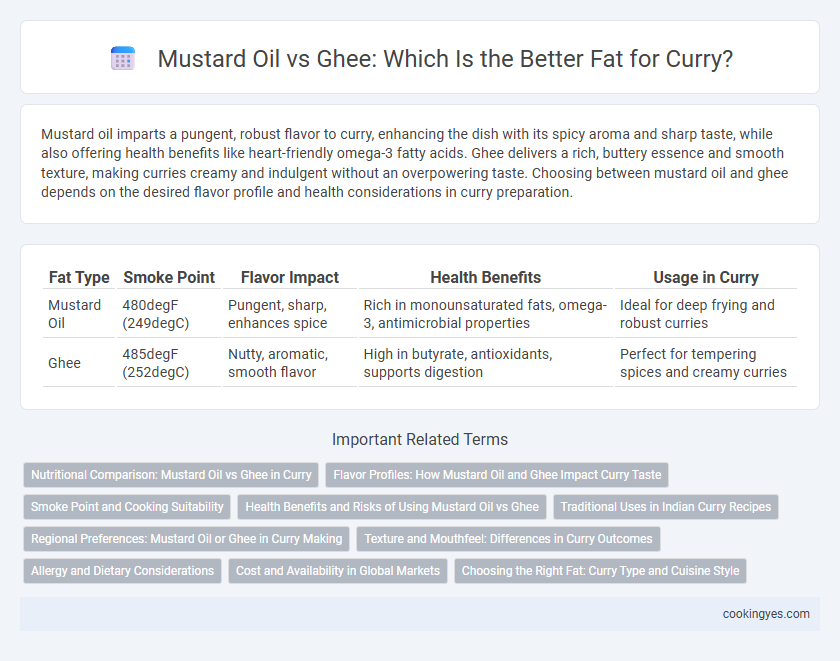Mustard oil imparts a pungent, robust flavor to curry, enhancing the dish with its spicy aroma and sharp taste, while also offering health benefits like heart-friendly omega-3 fatty acids. Ghee delivers a rich, buttery essence and smooth texture, making curries creamy and indulgent without an overpowering taste. Choosing between mustard oil and ghee depends on the desired flavor profile and health considerations in curry preparation.
Table of Comparison
| Fat Type | Smoke Point | Flavor Impact | Health Benefits | Usage in Curry |
|---|---|---|---|---|
| Mustard Oil | 480degF (249degC) | Pungent, sharp, enhances spice | Rich in monounsaturated fats, omega-3, antimicrobial properties | Ideal for deep frying and robust curries |
| Ghee | 485degF (252degC) | Nutty, aromatic, smooth flavor | High in butyrate, antioxidants, supports digestion | Perfect for tempering spices and creamy curries |
Nutritional Comparison: Mustard Oil vs Ghee in Curry
Mustard oil is rich in monounsaturated fatty acids, omega-3 and omega-6 fatty acids, and antioxidants, promoting heart health and anti-inflammatory benefits in curry dishes. Ghee contains saturated fats and fat-soluble vitamins A, D, E, and K, supporting energy levels and digestion but may raise cholesterol if consumed excessively. Choosing between mustard oil and ghee for curry fat depends on dietary goals, with mustard oil favored for cardiovascular benefits and ghee for its rich flavor and nutrient density.
Flavor Profiles: How Mustard Oil and Ghee Impact Curry Taste
Mustard oil imparts a sharp, pungent flavor with a slightly bitter undertone that enhances the spiciness of curry, creating a robust and earthy taste profile. Ghee offers a rich, nutty aroma and creamy texture, adding depth and smoothness that balances fiery spices and elevates the overall warmth of the dish. Choosing between mustard oil and ghee significantly influences curry's flavor intensity and mouthfeel, shaping the regional authenticity and sensory experience.
Smoke Point and Cooking Suitability
Mustard oil has a high smoke point of around 480degF (250degC), making it ideal for frying and sauteing in curries that require high-heat cooking without breaking down or burning. Ghee's smoke point is slightly lower, approximately 450degF (232degC), but it provides a rich, nutty flavor that enhances the depth of slow-cooked or simmered curries. Both fats suit different cooking methods: mustard oil works best for stir-frying or tempering spices, while ghee excels in thick, creamy curry bases where gradual heat develops flavor.
Health Benefits and Risks of Using Mustard Oil vs Ghee
Mustard oil contains high levels of monounsaturated fatty acids and omega-3 fatty acids, which support heart health and reduce inflammation, but its erucic acid content poses potential cardiovascular risks if consumed excessively. Ghee offers a rich source of fat-soluble vitamins A, D, E, and K, along with butyrate, promoting gut health and anti-inflammatory effects, though its high saturated fat content can increase LDL cholesterol and cardiovascular risk if overused. Choosing between mustard oil and ghee depends on balancing their unique fatty acid profiles and potential health impacts based on individual dietary needs and cooking methods.
Traditional Uses in Indian Curry Recipes
Mustard oil and ghee are iconic fats used in traditional Indian curry recipes, each imparting distinct flavors and health benefits. Mustard oil, rich in omega-3 fatty acids, is favored in Northern and Eastern India for its pungent, sharp aroma that enhances mustard seeds and green chili tempering. Ghee, clarified butter with a nutty taste, is valued across many Indian regions for its ability to enrich the curry's texture and retain long-lasting heat during slow cooking.
Regional Preferences: Mustard Oil or Ghee in Curry Making
Mustard oil is predominantly used in Eastern Indian and Bangladeshi cuisines for its pungent flavor and high smoking point, making it ideal for frying spices in curries. Ghee, favored in Northern and Western India, adds a rich, nutty taste and creamy texture, enhancing the depth of dishes like butter chicken or dal makhani. Regional preferences for curry fats reflect local agricultural practices and cultural tastes, influencing distinct curry profiles across India and Bangladesh.
Texture and Mouthfeel: Differences in Curry Outcomes
Mustard oil imparts a sharp, pungent texture and a slightly gritty mouthfeel to curry, enhancing bold flavor profiles. Ghee offers a rich, smooth, and creamy texture that coats ingredients evenly, creating a velvety mouthfeel. The choice between mustard oil and ghee significantly influences the curry's overall sensory experience, with mustard oil yielding a more robust texture and ghee providing luxurious mouth-coating richness.
Allergy and Dietary Considerations
Mustard oil and ghee both serve as popular fats in curry preparation but differ in allergy and dietary considerations. Mustard oil contains allergens that may trigger reactions in sensitive individuals, making it unsuitable for those with mustard allergies, while ghee, derived from clarified butter, is generally lactose-free and tolerated by many with dairy sensitivities. Choosing between mustard oil and ghee depends on individual dietary restrictions, allergy profiles, and desired flavor profiles in the curry.
Cost and Availability in Global Markets
Mustard oil offers a cost-effective option for curry preparation, often priced lower than ghee, with wide availability in South Asian and Southeast Asian markets but limited presence globally. Ghee, though more expensive due to the elaborate clarification process and premium dairy sourcing, enjoys a broader international distribution through specialty and health food retailers. Market demand and regional preferences largely influence pricing and accessibility, with ghee favored in Western and Middle Eastern cuisines, while mustard oil remains staple in traditional Indian and Bangladeshi kitchens.
Choosing the Right Fat: Curry Type and Cuisine Style
Choosing the right fat for curry depends on the type of curry and regional cuisine style, as mustard oil imparts a pungent, sharp flavor ideal for North Indian and Bengali dishes, enhancing their robust spices. Ghee offers a rich, nutty taste with a smooth texture, commonly preferred in South Indian and Mughlai cuisines for creamy, slow-cooked gravies. Balancing the fat choice with the curry's spice level and cooking method ensures authentic taste and desired mouthfeel.
Mustard oil vs ghee for curry fat Infographic

 cookingyes.com
cookingyes.com